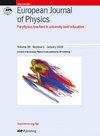弹簧枪的内部弹道
IF 0.8
4区 教育学
Q4 EDUCATION, SCIENTIFIC DISCIPLINES
引用次数: 0
摘要
我们考虑了在有限质量的减压弹簧的弹性力作用下弹丸的运动特征。弹丸的枪口速度随着弹簧和弹丸质量比的增大而减小。在一般情况下,弹丸在拉伸过程中会与弹簧失去接触。产生这种效果的原因是弹性位移波的峰值从固定端传播到弹簧的另一端。当小球的相对质量较大时,它会沿着正弦曲线的四分之一加速。在弹丸质量很小的情况下,弹丸几乎一直以几乎恒定的速度沿弹簧末端运动,大约等于声音在弹簧中的传播速度。在这种情况下,在初始压缩后,小球通过平衡位置,并在平衡位置外移动类似的距离后脱落。本文章由计算机程序翻译,如有差异,请以英文原文为准。
The internal ballistics of a spring gun
We consider the features of pellet motion under the elastic force acting from a decompressing spring of a finite mass. The muzzle speed of the pellet decreases as the ratio between spring and pellet mass increases. In the general case, the pellet loses contact with the spring as it is stretched. This effect occurs due to the fact that the peak of elastic displacement wave, propagating from the fixed end, reaches the opposite end of the spring. With a large relative mass of the pellet, it accelerates along a quarter of the sinusoid. At the limit of a very small pellet mass, it moves nearly all the time along with the end of the spring at an almost constant speed, approximately equal to the speed of sound propagation in the spring. In this case, after the initial compression, the pellet passes the equilibrium position, and comes off after moving a similar distance beyond the equilibrium.
求助全文
通过发布文献求助,成功后即可免费获取论文全文。
去求助
来源期刊

European Journal of Physics
物理-物理:综合
CiteScore
1.70
自引率
28.60%
发文量
128
审稿时长
3-8 weeks
期刊介绍:
European Journal of Physics is a journal of the European Physical Society and its primary mission is to assist in maintaining and improving the standard of taught physics in universities and other institutes of higher education.
Authors submitting articles must indicate the usefulness of their material to physics education and make clear the level of readership (undergraduate or graduate) for which the article is intended. Submissions that omit this information or which, in the publisher''s opinion, do not contribute to the above mission will not be considered for publication.
To this end, we welcome articles that provide original insights and aim to enhance learning in one or more areas of physics. They should normally include at least one of the following:
Explanations of how contemporary research can inform the understanding of physics at university level: for example, a survey of a research field at a level accessible to students, explaining how it illustrates some general principles.
Original insights into the derivation of results. These should be of some general interest, consisting of more than corrections to textbooks.
Descriptions of novel laboratory exercises illustrating new techniques of general interest. Those based on relatively inexpensive equipment are especially welcome.
Articles of a scholarly or reflective nature that are aimed to be of interest to, and at a level appropriate for, physics students or recent graduates.
Descriptions of successful and original student projects, experimental, theoretical or computational.
Discussions of the history, philosophy and epistemology of physics, at a level accessible to physics students and teachers.
Reports of new developments in physics curricula and the techniques for teaching physics.
Physics Education Research reports: articles that provide original experimental and/or theoretical research contributions that directly relate to the teaching and learning of university-level physics.
 求助内容:
求助内容: 应助结果提醒方式:
应助结果提醒方式:


